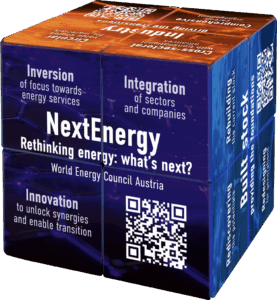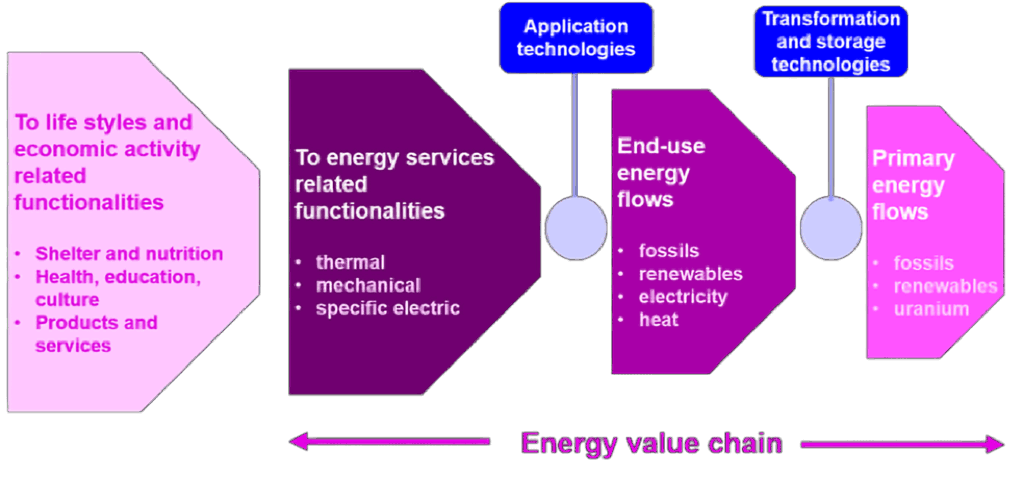A new, more advanced phase of energy-system thinking is taking shape, guided by the pioneering 3-I intentions aimed at radical transformations:
- Inversion
Any analysis should start with the final energy services actually needed rather than with primary energy inputs, as is traditionally done. - Integration
Every action should be evaluated for its effects on the entire energy system and beyond, not as an isolated action. - Innovation
Breakthrough improvements should be sought, and system-wide synergies should be unlocked by pursuing bold, coordinated interventions.
Together, these principles reorient discussion, deepen understanding, and sharpen the implementation of actions that can reshape our energy systems.
Inversion of focus towards energy services
Energy services are the use-value we actually want from energy, not the kilowatt-hours, cubic meters of gas, or liters of fuel themselves.
Energy services need a tailored metric – for example, the volume of indoor space that needs to be kept at comfortable temperatures or the distance people and goods need to travel. Within the energy chain, the concept that comes closest to capturing these services is the so-called useful energy. This is a breakdown of the various energy service categories:
- Thermal energy services
Cover everything from low-temperature heating and cooling in buildings to high-temperature applications in industrial processes. - Mechanical energy services
Supplied by stationary engines of various sizes and by mobile engines, most notably those in transport vehicles. - Specific electric energy services
Encompass electricity for lighting as well as for devices that contain electronic components.
Shifting the focus to energy services profoundly influences how we understand energy use and shape the design of energy systems.
Integration of sectors and companies along the energy value chain
Once the required energy services are clear, the next step is to select the appropriate energy value chain. Its main components are:
- Useful energy
is set by the end-use technology that delivers the desired service.
In buildings, thermal services depend on the envelope’s thermal quality and on the performance of the heating and cooling systems. - Primary energy
is under the intention of inversion the destination, not the starting point, of the energy value chain.
The core decision is whether that energy comes from renewable or fossil sources, and whether it is obtained domestically or imported. - Transformation, distribution, and storage
Are further essential stages in the energy value chain.
Multiple criteria support this choice of the energy value chain. These are some of the requirements to be considered:
- Resilience, availability, emissions, and costs
All hinge on the interactions among the components of the energy value chain. - Efficiency and exergy
Concern the quantity of energy—and the quality (exergy)—needed to deliver a specific service.
Matching sector and company scopes
Demands a nuanced grasp of cross-sector collaboration and evolving business models.
Innovation to unlock synergies and enable transition
Targeted innovations uncover substantial potential, paving the way for radical transitions and a broad array of benefits. The following examples are grouped by their strategic scope.
Structural strategies (S3)
connect energy with the management of materials in a circular economy
- Adaptable urban ensembles
Neighborhoods are built as highly flexible structures whose functions can change over their lifetime, and reduce mobility demand. - Circular use of building materials
In a circular economy that also captures and recycles carbon, components of the existing building stock are treated as resources.
Systemic strategies (S2)
aim for transformative changes throughout the entire energy value chain.
- Energy hubs
are localized energy systems that integrate every supply- and demand-side component through active controls. - Anergy grids
are low-temperature district heating and cooling networks that recycle waste heat and connect to geothermal wells. - Thermal building components (TBC)
leverage the building’s structural mass as both a thermal storage medium and a platform for integrated photovoltaics.
Singular strategies (S1)
focus on isolated actions in energy supply and use, and therefore often overlook the synergies unlocked by systemic strategies (S2).
- Substitution of fossils with renewables
without assessing the implications for grid operation and demand-side management. - Isolated energy-efficiency improvements
without considering the synergies achievable through an integrated approach.


